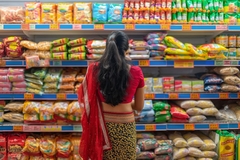
- Industry news
Industry news
- Category news
Category news
- Reports
- Key trends
- Multimedia
- Journal
- Events
- Suppliers
- Home
- Industry news
Industry news
- Category news
Category news
- Reports
- Key trends
- Multimedia
- Events
- Suppliers
FDA cracks down on eight synthetic food dyes amid growing health concerns

The FDA is set to ban the use of Citrus Red No. 2 and Orange B in F&B products in the coming months as part of its broader initiative to phase out all petroleum-based synthetic dyes from the US food supply. As part of this strategy, the agency also plans to authorize four new natural color additives in the weeks ahead and speed up the review and approval of others to help companies find substitutes faster.
The food authority is working with the industry to eliminate six remaining synthetic dyes — FD&C Green No. 3, FD&C Red No. 40, FD&C Yellow No. 5, FD&C Yellow No. 6, FD&C Blue No. 1, and FD&C Blue No. 2 — from the food supply by the end of next year.

The move will restore “gold-standard science” and regain consumer trust, says HHS Secretary Robert F. Kennedy, Jr, whose “Make America Healthy Again” program aims to lower chronic disease rates and end childhood chronic disease.
“For too long, some food producers have been feeding Americans petroleum-based chemicals without their knowledge or consent,” he says.
“These poisonous compounds offer no nutritional benefit and pose real, measurable dangers to our children’s health and development. That era is coming to an end.”
Fast-tracking review and research
The FDA is speeding up the review of calcium phosphate, Galdieria extract blue, gardenia blue, butterfly pea flower extract, and other natural alternatives to synthetic food dyes.
 The FDA and HHS will work with food companies to remove food dyes from products, HHS Secretary Robert F. Kennedy, Jr. said at a news conference.The agency is also taking steps to issue guidance and provide regulatory flexibilities to industries.
The FDA and HHS will work with food companies to remove food dyes from products, HHS Secretary Robert F. Kennedy, Jr. said at a news conference.The agency is also taking steps to issue guidance and provide regulatory flexibilities to industries.
Moreover, it requests food companies to remove FD&C Red No. 3 “sooner than the 2027-2028 deadline previously required.”
In December, the agency told Food Ingredients First that it was actively reviewing a petition filed for the color, which it banned in January after three decades of debate and cancer concerns
Protecting children’s health
FDA Commissioner Marty Makary, MD, MPH, says the agency wants food companies to “substitute petrochemical dyes with natural ingredients” for US children, similar to the EU and Canada.
“We have a new epidemic of childhood diabetes, obesity, depression, and ADHD. Given the growing concerns of doctors and parents about the potential role of petroleum-based food dyes, we should not be taking risks and do everything possible to safeguard the health of our children.”
The FDA is also collaborating with the National Institutes of Health to conduct “comprehensive research” on how food additives impact children’s health and development.
Dairy focus
Amid the US’s crackdown on petroleum-based dyes, the International Dairy Foods Association (IDFA) has also announced it will eliminate the use of Red 3, Red 40, Green 3, Blue 1, Blue 2, Yellow 5, and Yellow 6 in any milk, cheese, or yogurt products sold to K-12 schools for reimbursable school meals by July 2026.
 The US also plans to eliminate the use of some red, blue, green and yellow dyes in dairy products sold to K-12 schools by July 2026.The move goes “above and beyond state and federal regulations” to ensure children have access to these dairy products without any certified artificial colors, says Michael Dykes, D.V.M., IDFA president and CEO.
The US also plans to eliminate the use of some red, blue, green and yellow dyes in dairy products sold to K-12 schools by July 2026.The move goes “above and beyond state and federal regulations” to ensure children have access to these dairy products without any certified artificial colors, says Michael Dykes, D.V.M., IDFA president and CEO.
US Secretary of Agriculture Brooke Rollins applauded the move that is set to “reshape school meal menus” for the country’s 30 million children.
“America’s dairy farmers and milk processors have always led the way in providing our families and schoolchildren with healthy, nutritious, and delicious milk products.”
He believes the announcement shows how the dairy industry is voluntarily driving change and “giving consumers what they want, without government mandates.”










